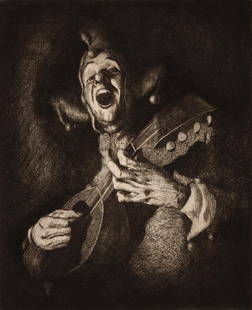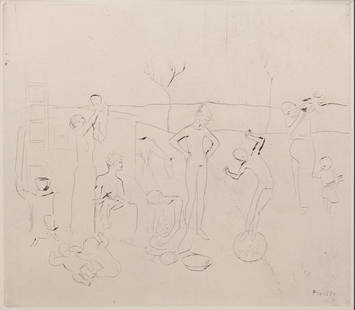
ALFRED HRDLICKA (1928-2009, Austria) Self Portrait
Similar Sale History
View More Items in Prints & MultiplesRelated Prints & Multiples
More Items in Modern Prints & Multiples
View MoreRecommended Art
View More



Item Details
Description
Etching on paper 10 3/4 x 8 in. (plate). "Alfred Hrdlicka Obituary," The Guardian, newspaper, London, February 13, 2010, WebThe Austrian artist Alfred Hrdlicka, who has died aged 81, was a controversial, radical figure whose work was driven by his political beliefs and profound sense of humanity. His notoriety peaked in 2008 with the exhibition of his painting Leonardo's Last Supper, Restored By Pier Paolo Pasolini. Although the title alone spells trouble, the picture was initially accepted by the conservative Cardinal Christoph Schönborn for the show "Religion, Flesh and Power" at the Cathedral Museum in Vienna.When Christians around the world expressed their anger at Hrdlicka's seething, homoerotic image, the Church authorities removed it, claiming that this was done out of "reverence for the sacred" rather than censorship. As Hrdlicka himself remarked, the only surprise was that they had agreed to display the work in the first place.He was born in Vienna into a family of Czech descent. His mother and brother were both professionally involved in psychoanalysis, which later influenced Alfred, although he was never a full-blown Freudian. He inherited leftist convictions from his father, who was arrested for communist activities in 1934, four years before Austria was incorporated into the Third Reich. Only his age spared Hrdlicka from fighting for Germany during the second world war; his brother was killed in 1942 during the siege of Leningrad.After an apprenticeship as a dental technician, Hrdlicka began his artistic training at the age of 18 under Albert Paris von Gütersloh, an exuberant, lyrical expressionist. Seven years later, Hrdlicka continued his education with the sculptor Fritz Wotruba, whose austere, geometric style exerted some influence on him during the 1950s.Ultimately the younger artist came to see modernism as too remote from real life and began to concentrate on a more vigorous, carnal approach. Hrdlicka's hostility to abstraction produced the print cycle Roll Over Mondrian (1966) and an article with the same title, which he wrote in 1967. He also declared that "all power derives from the flesh", a belief that was powerfully illustrated by Friends (1964-65), a heavily textured marble relief of two naked women.With their contorted, at times fragmented, figures, Hrdlicka's works were meant above all to express themes of oppression and alienation. His numerous statues of Marsyas, the mythical character flayed for challenging Apollo to a musical contest, are intended as symbols of anti-authoritarianism, while other pieces refer directly to the outsider in contemporary society.These images are extremely varied. The prints known as Striptease in Soho, the result of a trip to London in 1966, examine the experiences of sex workers, while others drew on Hrdlicka's study of psychiatric patients, some of whom he subsequently interviewed in a TV documentary, in 1972. Many of these works are enigmatic and allusive, but all have a strong graphic style, with dramatic tonal effects created from pools of black ink.Like his father, Hrdlicka was a lifelong Marxist. Although he resigned from the Austrian Communist party after the invasion of Hungary in 1956, he maintained cultural links with East Germany throughout the cold war, as well as collaborating with left-wing western artists such as the Italian composer Luigi Nono, for whom in 1992 he designed the set of the opera Intolleranza 1960.He appeared in anti-fascist demonstrations, particularly during the election of Kurt Waldheim as Austria's president in 1986, when he made a grotesque wooden horse mocking Waldheim's attempts to distance himself from his past. Who was the Nazi: Waldheim or his horse?Marxist or anti-fascist themes also inspired some of Hrdlicka's most accomplished sculptures, from the Friedrich Engels memorial (1981) in Wuppertal to the Memorial against War and Fascism (1991) in Vienna. With its bronze figure of a Jew coerced into washing the street, this monumental composition, in the Austrian capital's historic Albertinaplatz, attracted criticism for its unsentimental and anti-heroic imagery.The work, which has also been vandalised several times by neo-Nazis, typifies Hrdlicka's stubborn disregard for decorum and correctness – as well as his intuitive feeling for poses and gestures that get to the heart of the matter, however uncomfortable that may be.Despite his communist sympathies, Hrdlicka received significant commissions from Christian organizations, including a series of shocking, violent images for a Protestant community centre at Plötzensee in Berlin. In these contexts, Hrdlicka produced highly original variations on conventional subjects.Hrdlicka's identification of Jesus with the murdered, gay film-maker Pasolini led not only to his infamous version of the Last Supper but also to sculptures, prints and pastels in which the Italian director adopts poses associated with Christ's Passion. These works reveal Hrdlicka's preoccupation with the creative outsider, one of the leitmotifs of his career, and exemplify his mastery of human anatomy.Hrdlicka was predeceased by his wife, Barbara, in whose honour he made a memorial that was installed in 1995 at the Central cemetery in Vienna.Alfred Hrdlicka, artist, born 27 February 1928; died 5 December 2009
Condition
Good condition
Buyer's Premium
- 25%
ALFRED HRDLICKA (1928-2009, Austria) Self Portrait
Estimate $300 - $600
4 bidders are watching this item.
Shipping & Pickup Options
Item located in Margate City, NJ, usSee Policy for Shipping
Payment

TOP
































































![[SEX] LOT OF 9 PHOTOGRAPHS SOLD TOGETHER: [SEX] A lot of 9 photographs sold together. Some postcards. One mounted with plastic corners in archival mat. Prints: 4.5" x 3" - 6" x 4". Generally good condition, various imperfections. *Additional](https://p1.liveauctioneers.com/8124/329546/177689790_1_x.jpg?height=310&quality=70&version=1715469494)

![Emilio Grau-Sala "Sur la Plage" Oil on Canvas: Emilio Grau-Sala (Spanish, 1911-1975), "Sur la Plage" [On The Beach], Oil on Canvas, 1958, signed "Grau Sala" lower right, signed, inscribed "Trouville", dated, and titled to verso. Image: 21.5" H x 2](https://p1.liveauctioneers.com/5649/328023/176731071_1_x.jpg?height=310&quality=70&version=1714409606)












